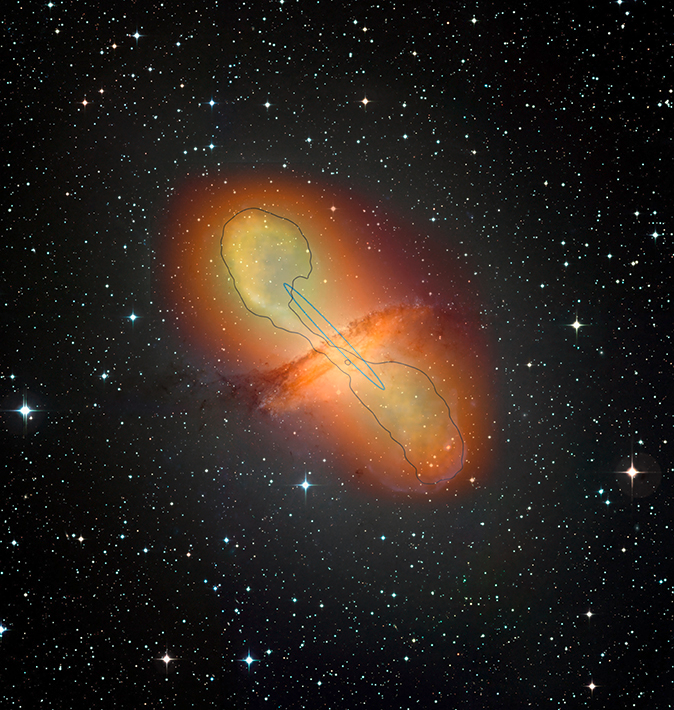Jun 18 2020
An international team of more than 200 researchers from 13 countries has demonstrated that the emission of very high-energy gamma-rays from quasars—galaxies with a highly energetic nucleus—is not focused in the region close to their central black hole but extends over several thousand light-years across jets of plasma.
 Composite image of Centaurus A, showing the jets emerging from the galaxy’s central black hole, together with the associated gamma radiation. Image Credit: © ESO/WFI (Optical); MPIfR/ESO/APEX/A.Weiss et al. (Submillimeter); NASA/CXC/CfA/R.Kraft et al. (X-ray), H.E.S.S. collaboration (Gamma).
Composite image of Centaurus A, showing the jets emerging from the galaxy’s central black hole, together with the associated gamma radiation. Image Credit: © ESO/WFI (Optical); MPIfR/ESO/APEX/A.Weiss et al. (Submillimeter); NASA/CXC/CfA/R.Kraft et al. (X-ray), H.E.S.S. collaboration (Gamma).
This finding throws the existing scenarios for the behavior of such plasma jets into question. The study, reported in the Nature journal on June 18th, 2020, was performed as part of the H.E.S.S collaboration, which specifically involves the CNRS and CEA in France, as well as the Max Planck Society and other universities and research institutions in Germany.
In the recent past, researchers have observed gamma rays, which are very high-energy photons, in the Universe. Gamma rays form part of the cosmic rays constantly bombarding the Earth and originating from regions of the Universe in which particles are accelerated to considerable energies that cannot be achieved in human-developed accelerators.
Various cosmic objects, including quasars that are active galaxies with a highly energetic nucleus, emit gamma rays. The intensity of the radiation from such systems can differ over very short timescales of up to a minute.
Researchers considered that the source of this radiation was extremely small and situated close to a supermassive black hole, with a mass several billion times that of the Sun.
The black hole devours the matter that spirals down into it and ejects a small portion of it in the form of large plasma jets at relativistic speeds close to that of light. This contributes to the redistribution of matter all through the Universe.
The international astrophysics collaboration used the H.E.S.S. observatory in Namibia to observe a radio galaxy—a galaxy that appears highly luminous upon observation at radio wavelengths—for more than 200 hours at unmatched resolution.
Centaurus A is the radio galaxy nearest to Earth and is preferred by researchers for such a study, which allows them to find the region that emits the very high-energy radiation while analyzing the trajectory of the plasma jets. They could demonstrate that the gamma-ray source extends over several thousand light-years.
Such an extended emission shows that particle acceleration does not occur only close to the black hole but along the entire length of the plasma jets. From the new results, it is considered that stochastic processes reaccelerate the particles along the jet.
From these findings, it is evident that several radio galaxies, including extended jets, accelerate electrons to higher energies and could emit gamma-rays, which is a possible explanation for the origins of a major fraction of the diffuse extragalactic gamma background radiation.
The study outcomes offer crucial, novel insights into cosmic gamma-ray emitters, specifically regarding the role of radio galaxies as highly efficient relativistic electron accelerators. Since they are large in number, radio galaxies would seem to collectively contribute in a highly significant way to the redistribution of energy in the intergalactic medium.
The findings necessitated optimized analysis techniques and extensive observations with H.E.S.S., the world’s most sensitive gamma-ray observatory. Next-generation telescopes such as the Cherenkov Telescope Array (CTA) will surely enable the observation of this phenomenon in much greater detail.
Journal Reference:
The H.E.S.S. Collaboration (2020) Resolving acceleration to very high energies along the jet of Centaurus A. Nature. doi.org/10.1038/s41586-020-2354-1.